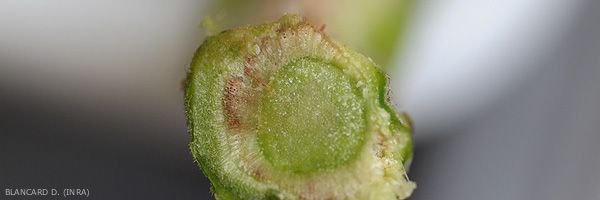
Fusarium oxysporum f. sp. lycopersici
W.C. Snyder & H.N. Hansen, (1940)
Fusarium wilt
- classification : Fungi, Ascomycota, Sordariomycetes, Hypocreomycetidae, Hypocreales, Nectriaceae
- téléomorphe : Gibberella
- English name: Fusarium wilt
Fusarium oxysporum f.sp. lycopersici soil is a fungus found worldwide . First described in Europe at the end of the 19th century, it is now present in several dozen countries spread over all continents, where its damage fluctuates depending on the breed and variety cultivated. In the past, it caused more or less considerable damage, especially before resistant varieties became available. The use of such varieties has made it possible and still makes it possible to limit its incidence in many countries. This is particularly the case in France , where fusarium wilt is hardly ever expressed . Recently, the use of old varieties, which have become fashionable again, has allowed Fusarium wilt to emerge occasionally, for example in the South-West.
In addition, and unfortunately, several breeds have gradually come to question resistance to Fusarium wilt in certain production areas. Thus, three physiological races1 are now known on tomato:
- race 1, the oldest, described in 1886, is widely present in many production areas;
- race 2, reported in 1945 in Ohio, became serious from the 1960s in several countries: United States, Mexico, Brazil, Venezuela, Australia, Great Britain, Netherlands, Israel, Morocco, Iraq , Taiwan, China ;
- the most recent, race 3, has a more limited distribution area. Described in 1978 in Australia and capable of overcoming the "I" and "I-2" genes, it is now rampant in Brazil, a few states in the United States, Mexico, Japan
Several vegetative compatibility groups (VCGs) have been observed in F. oxysporum f. sp. lycopersici . Races 1 and 2 would belong to groups VCG 0030 and VCG 0032, race 3 to groups VCG 0030 and VCG 0033. As an example, note the study carried out in California, 2 years after the appearance of race 3. Analysis of 39 isolates showed that 22 of them could be associated with the VCG 0030 group (13 with race 3 and 9 with race 2), 11 with the VCG 0031 group (7 with race 2 and 1 to race 1) and 6 to a new group VCG 0035 (all race 2). Additionally, this work would suggest that race 3, which was found in California, originated from a local race 2.





